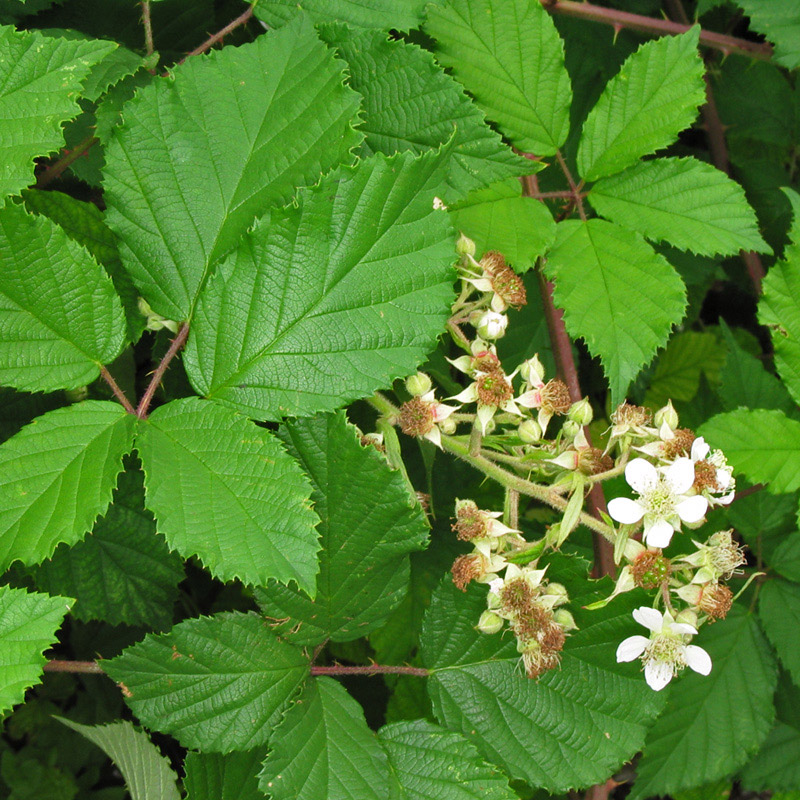Botanical name
Rubus fruticosus L.
Family
Rosaceae
Common name
Brambles, Blackberry, European blackberry
Information about the plant
The botanical name Rubus fruticosus refers to a collective species that includes many related species, which are difficult to distinguish. In Central Europe, around 70 wild, cultivated, and naturalized blackberry species are known. In temperate zones, the blackberry is widespread worldwide, partly naturalized and often hybridized with native species. In Germany, it grows wild in forest clearings, on forest edges, and in bushes. Its black berries are collected, but the blackberry is also highly valued as a cultivated plant. The black berries are processed into jelly, jam, fruit purée, and fruit juices.
The genus name Rubus comes from the Indo-European and is derived from ‘reub-’ (= to tear), meaning a shrub that is torn. This is due to the pointed spines on the stems and leaf veins, which are also found on the raspberry (Rubus idaeus). The species epithet fruticosus is Latin and means ‘full of bushes’, in technical language ‘shrubby’, derived from the Latin ‘frutex’ (= bush). The German name ‘Brombeere’ is derived from the Old High German ‘bramo’ = thorn bush and ‘beri’ = berry.
The spiny blackberry bush grows up to 3 meters tall and has three to five leaflets; these are hairy underneath and have a spiny midrib. The white to pale pink flowers are borne in richly flowered, paniculate, elongated, or compressed inflorescences on the side shoots. The fruits are red when unripe and ripen from purple to black. Botanically, the blackberry is an aggregate drupe: many small drupes sit on a slightly conical fruit axis and, unlike raspberries, remain attached to this when ripe, whereby the fruit axis also becomes juicy as it ripens.
Medicinally used parts of plants (herbal drug)
The dried leaves collected during the flowering period (blackberry leaves - Rubi fruticosi folium) are used.
The commercially available drug comes from wild sources in Central and Eastern Europe.
Constituents of the herbal drug
Blackberry leaves contain tannins (mainly gallo- and ellagitannins) and flavonoids.
Quality of the drug
The quality of blackberry leaves (Rubi fruticosi folium) is specified in the German Drug Codex (DAC).
Medical applications
Recognised medical use
Blackberry leaves have not been evaluated by the HMPC or the ESCOP.
Traditional use
Blackberry leaves have not been classified as a traditional medicinal product (Article 16a of Directive 2001/83/EC).
Herbal drug preparations in finished dosage forms
Cut blackberry leaves are used in tea preparations, usually as part of tea blends.
Dosage
Finished medicinal product: see patient information leaflet.
Tea: Drink 1 cup of warm blackberry leaf tea 3 to 4 times a day between meals. Daily dose 4 to 6 g of the drug. The tea can also be used to mouthwash and for gargling.
Preparation of a tea
Pour approximately 150 mL of boiling water over 1.5 g of finely cut blackberry leaves and strain after 10 minutes; cold preparation and brief boiling are also possible.
Notes
Medical advice must be sought in cases of prolonged and recurring diarrhea, and bloody stools.
No safety studies are available on the use of blackberry leaves during pregnancy and lactation. The use in children and adolescents under the age of 18 is not recommended due to a lack of evidence.
Side effects
None known.
Interactions
None known.


